FRISCO, Texas — Donovan Ezeiruaku never went more than two games last year at Boston College without a sack. He is six games into his Dallas Cowboys career, and the second-round defensive end is still looking for his first sack as a…
Blog
-
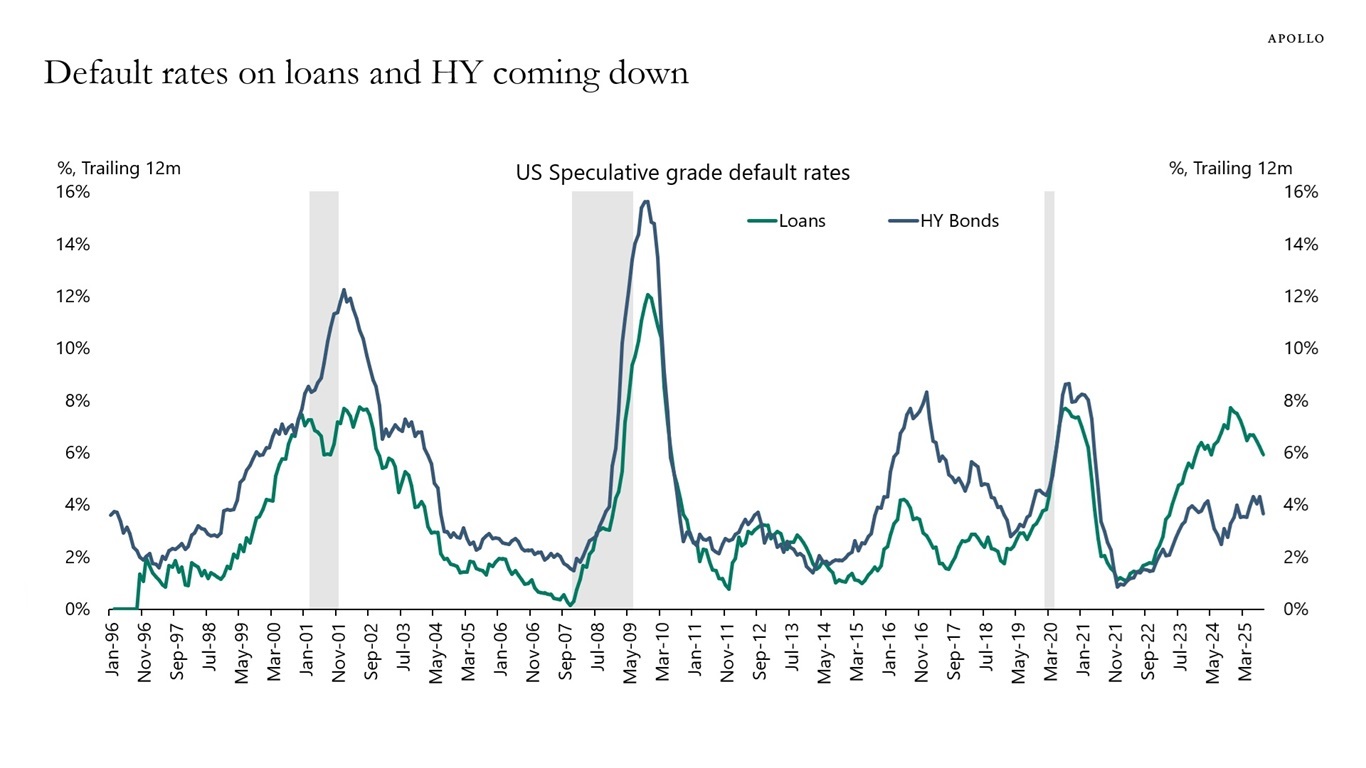
Negative Effects of the Trade War Offset by the AI Boom and the Industrial Renaissance
Contrary to widespread fears about the economic outlook, key credit indicators are turning more bullish. Default rates for high yield debt and loans have peaked, along with delinquency rates for auto loans and credit cards, see charts below.
Three factors explain why corporate default and consumer delinquency rates are moving lower:
1) Uncertainty related to the trade war is significantly lower than its peak during Liberation Day.
2) The ongoing AI boom is boosting the buildout of data centers and related energy infrastructure. Simultaneously, higher stock prices are supporting consumer spending.
3) Investors are increasingly recognizing that we are in the early stages of an industrial renaissance across sectors like aerospace, defense, manufacturing, biotech and technology/automation.
In summary, while the trade war remains a mild drag on growth, its impact is being more than offset by the tailwinds from the AI boom and the industrial renaissance. Consequently, there is a growing upside risk that economic growth will reaccelerate over the coming quarters.
Sources: Moody’s Analytics, Apollo Chief Economist 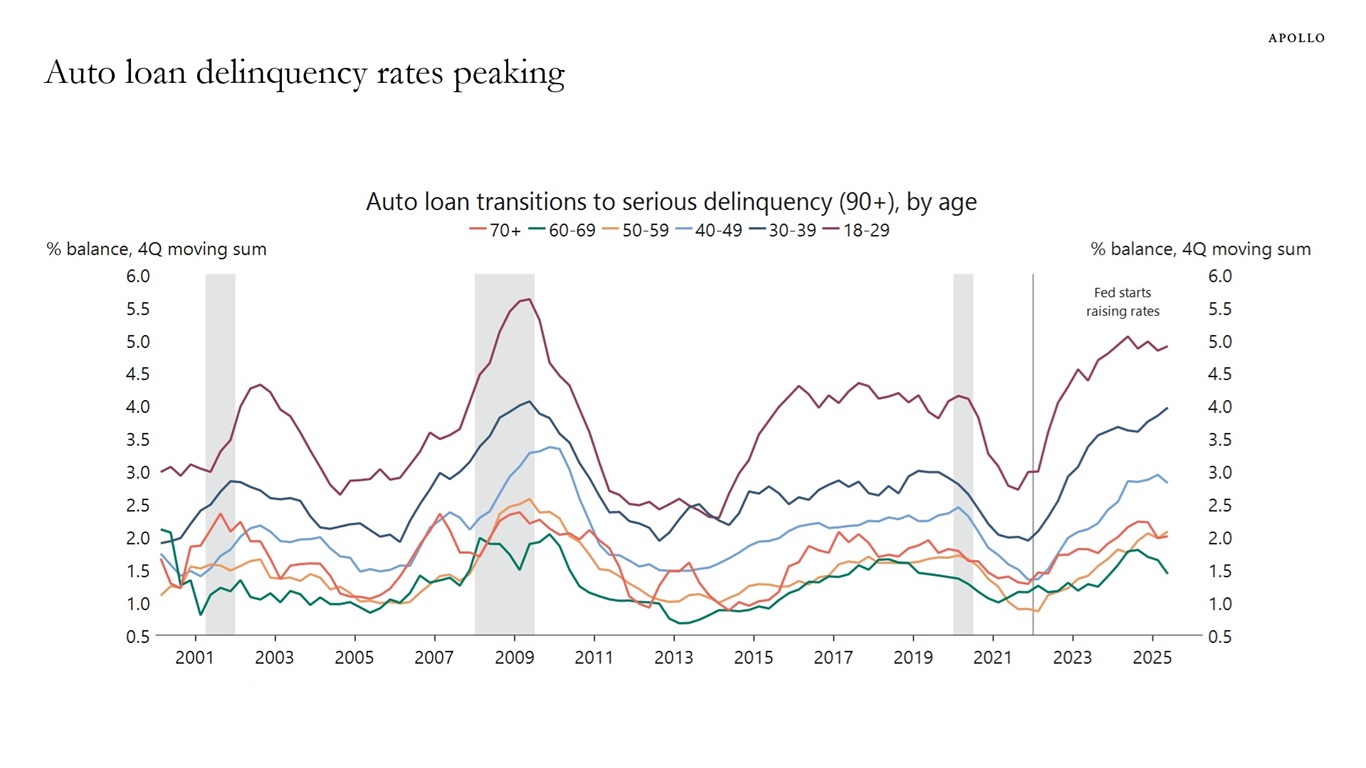
Sources: Federal Reserve Bank of New York, Macrobond, Apollo Chief Economist 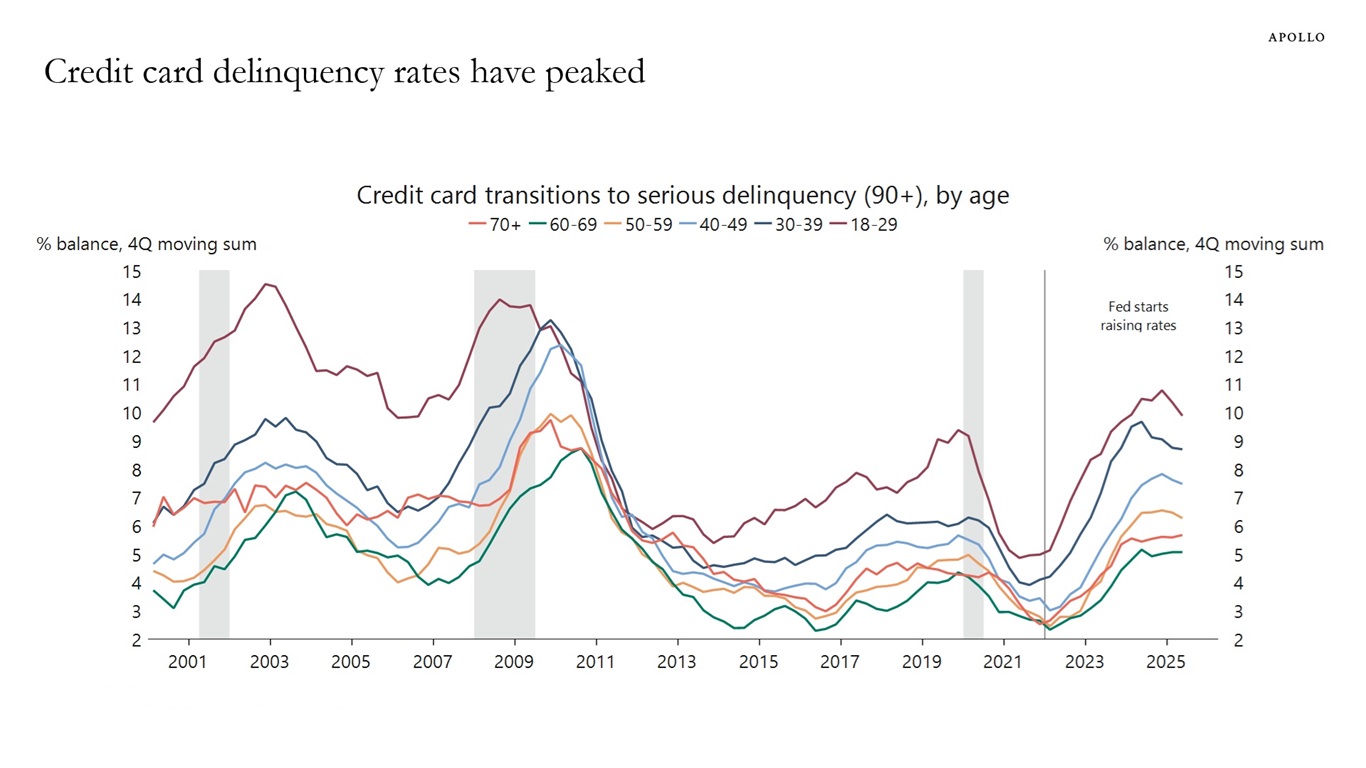
Sources: Federal Reserve Bank of New York, Macrobond, Apollo Chief Economist Download high-res charts
This presentation may not be distributed, transmitted or otherwise communicated to others in whole or in part without the express consent of Apollo Global Management, Inc. (together with its subsidiaries, “Apollo”).
Apollo makes no representation or warranty, expressed or implied, with respect to the accuracy, reasonableness, or completeness of any of the statements made during this presentation, including, but not limited to, statements obtained from third parties. Opinions, estimates and projections constitute the current judgment of the speaker as of the date indicated. They do not necessarily reflect the views and opinions of Apollo and are subject to change at any time without notice. Apollo does not have any responsibility to update this presentation to account for such changes. There can be no assurance that any trends discussed during this presentation will continue.
Statements made throughout this presentation are not intended to provide, and should not be relied upon for, accounting, legal or tax advice and do not constitute an investment recommendation or investment advice. Investors should make an independent investigation of the information discussed during this presentation, including consulting their tax, legal, accounting or other advisors about such information. Apollo does not act for you and is not responsible for providing you with the protections afforded to its clients. This presentation does not constitute an offer to sell, or the solicitation of an offer to buy, any security, product or service, including interest in any investment product or fund or account managed or advised by Apollo.
Certain statements made throughout this presentation may be “forward-looking” in nature. Due to various risks and uncertainties, actual events or results may differ materially from those reflected or contemplated in such forward-looking information. As such, undue reliance should not be placed on such statements. Forward-looking statements may be identified by the use of terminology including, but not limited to, “may”, “will”, “should”, “expect”, “anticipate”, “target”, “project”, “estimate”, “intend”, “continue” or “believe” or the negatives thereof or other variations thereon or comparable terminology.
Continue Reading
-

ALMA and JWST solve major star formation mystery: Space photo of the week
Quick facts
What it is: HH 211, a baby star erupting with gargantuan energy jets
Where it is: 1,000 light-years from Earth in the constellation Perseus.
When it was shared: Sept. 17, 2025
Most events in the universe are not fully understood,…
Continue Reading
-

Brain training game boosts chemical linked to memory and attention, study shows
With age comes a natural decline in cognitive function, even among otherwise healthy adults without dementia. A new study finds that a cognitive training program may boost production of a brain chemical that plays a role in memory and attention.
Continue Reading
-

As Pokémon Legends: Z-A launches, we return to Pokémon Legends: Arceus’ rose-tinted take on the past, and the hard questions it raises about Japanese history
Pokémon has always been a jet-setting series, with its head in the clouds and its feet planted firmly in the real world. The first four generations of Pokémon games took us on a whirlwind tour of Japan. Red and Blue were…
Continue Reading
-

Hospitals turn to music to help patients manage pain, anxiety
Nurse Rod Salaysay works with all kinds of instruments in the hospital: a thermometer, a stethoscope and sometimes his guitar and ukulele.
In the recovery unit of UC San Diego Health, Salaysay helps patients manage pain…
Continue Reading
-

Gaza ceasefire under strain after exchange of fire between Israel and Hamas
Unlock the Editor’s Digest for free
Roula Khalaf, Editor of the FT, selects her favourite stories in this weekly newsletter.
The week-old ceasefire in Gaza came under strain on Sunday with Israel launching air strikes in the south of the enclave…
Continue Reading
-
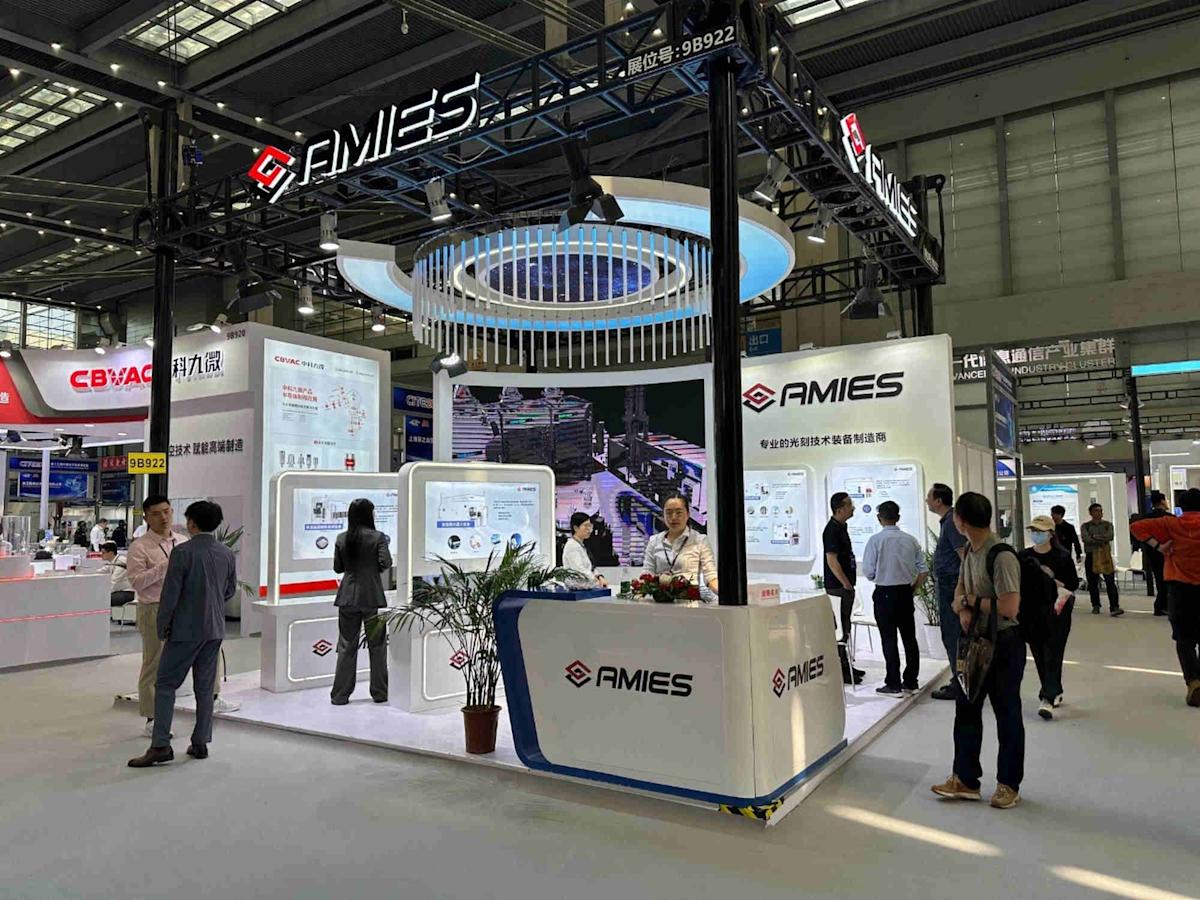
Meet AMIES, China’s new hope in breaking reliance on ASML’s chipmaking machines
AMIES Technology, a new Chinese lithography equipment manufacturer that showcased its latest chipmaking products at an industry event in Shenzhen last week, is offering renewed optimism in the nation’s drive to reduce its dependence on Dutch giant ASML.
The company presented a wide range of products – including compound-semiconductor lithography machines, laser-annealing systems, advanced inspection tools and solutions for packaging and wafer bonding – at the WeSemiBay Semiconductor Ecosystem Expo 2025, which featured more than 600 exhibitors, such as Huawei Technologies partner SiCarrier.
Advanced lithography remains a significant bottleneck in China’s chipmaking ambitions. The country still trails far behind global leaders in the technology and is restricted from acquiring ASML’s top deep ultraviolet (DUV) and extreme ultraviolet (EUV) systems due to US export controls.
Do you have questions about the biggest topics and trends from around the world? Get the answers with SCMP Knowledge, our new platform of curated content with explainers, FAQs, analyses and infographics brought to you by our award-winning team.
Founded in February, AMIES is a spin-off from China’s leading lithography company, the state-owned Shanghai Micro Electronics Equipment (SMEE). While SMEE focuses on developing essential front-end tools, AMIES aims to commercialise equipment more swiftly, according to Chinese media reports, citing company representatives.
US-sanctioned SMEE excels in back-end semiconductor processes like packaging, which often require less advanced lithography technology. When it comes to front-end wafer fabrication, however, it is still trying to catch up with Western leaders such as ASML.
AMIES was spun off from SMEE in February. Photo: Handout alt=AMIES was spun off from SMEE in February. Photo: Handout>
The Chinese company’s most reliable production-grade lithography tools are believed to support processes around 90-nanometre node and above. In late 2023, its shareholder Zhangjiang Group briefly claimed on social media that SMEE had “successfully developed a 28-nm lithography machine”, but later retracted the reference.
In contrast, ASML’s EUV systems are used by leading chipmakers for processes at 2-nm nodes and below.
For now, AMIES said its flagship product is its advanced packaging lithography machine, which held a global market share of 35 per cent and a 90 per cent share in China.
On its website, AMIES lists four product lines: integrated circuits, advanced packaging, compound semiconductors and flat-panel displays. These encompass various types of annealing, inspection, chip manufacturing and packaging tools.
Continue Reading
-

Oncologist explains why chemotherapy doesn’t work for certain breast cancer patients – Health News
Breast cancer remains the most common cancer among women worldwide. According to the World Health Organization (WHO), in 2024, around 2.4 million women were diagnosed with breast cancer globally, and approximately 685,000 women died from the…
Continue Reading
-
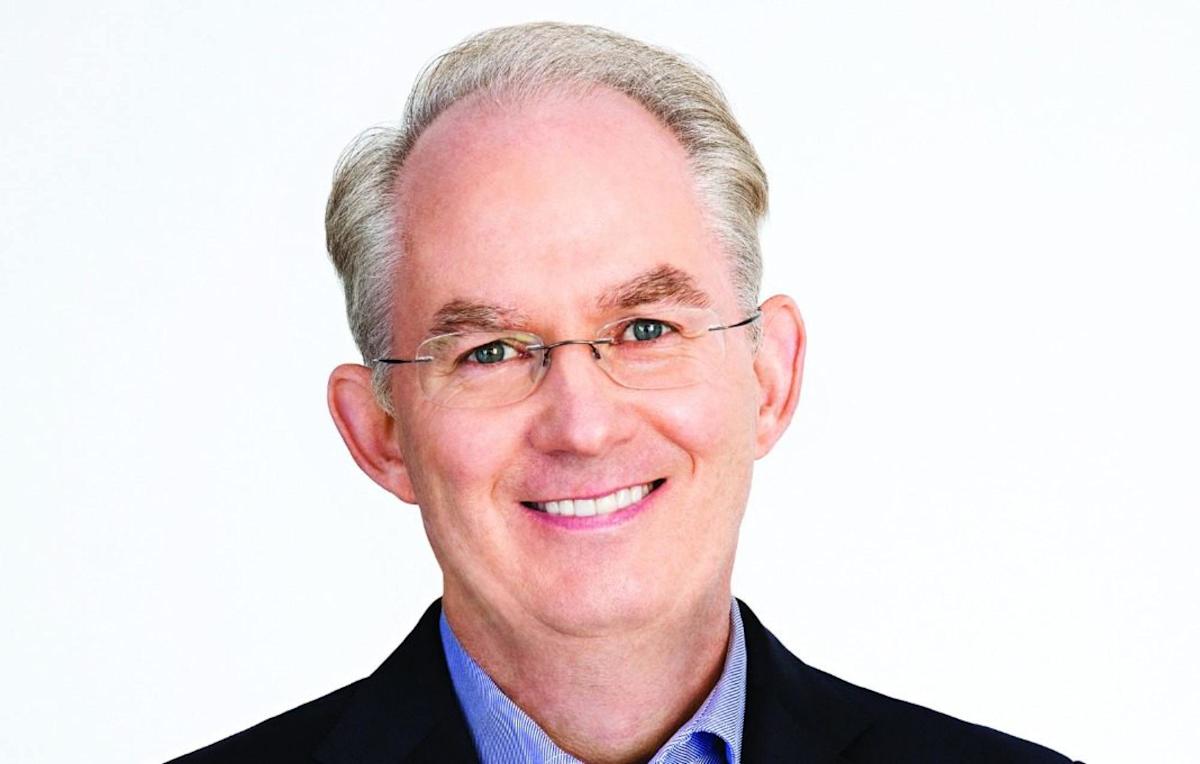
Fintech can be catalyst to make Hong Kong a next-level financial hub: Broadridge CEO
Embracing technology platforms for applications such as electronic proxy voting, private debt underwriting and trading of repurchase (repo) agreements can help Hong Kong elevate its standing as Asia’s top financial hub, according to a leading US fintech firm.
Technologies that simplified investor engagement had been a catalyst for growth in other markets, said Tim Gokey, CEO of New York-listed Broadridge Financial Solutions, adding that fintech could enhance corporate governance and product innovation to help the city strengthen its connections with mainland China and the wider world.
“We’re investing in the region and are excited to be part of the rapidly growing Hong Kong market, which is emerging as a leading financial hub in Asia and the primary point of connectivity between the mainland and global markets,” Gokey said in an interview during a trip to the city last month.
Do you have questions about the biggest topics and trends from around the world? Get the answers with SCMP Knowledge, our new platform of curated content with explainers, FAQs, analyses and infographics brought to you by our award-winning team.
His comments came before financial regulators in Hong Kong and mainland China unveiled a series of measures last month to allow cross-boundary bond repo business and to strengthen the city’s fixed income and currency markets – all initiatives that had been discussed and anticipated among market participants for a number of years.
“We see a strong opportunity to support that growth by enhancing trust and transparency in corporate governance,” added Gokey, whose firm doubled its Asian team to nearly 500 over the past five years, with Hong Kong accounting for more than 80 people.
As companies increasingly turned to capital markets, beyond banks, for fundraising, the transparency and trust of corporate governance became essential, he said, pointing to the US as an example.
Tim Gokey, CEO of New York-listed Broadridge Financial Solutions. Photo: Handout alt=Tim Gokey, CEO of New York-listed Broadridge Financial Solutions. Photo: Handout>
“Strong corporate governance is one of the key drivers behind the success and confidence in US capital markets,” he said. “It’s not the sole answer, but a crucial contributing factor.”
Broadridge’s corporate-governance offerings, including proxy-voting platforms, have a global reach, processing shares held in street names at more than 1,000 broker-dealers and custodian banks. Its proxy services covered about 80 per cent of outstanding shares of US publicly listed companies in 2023.
Continue Reading
